#technological innovations in warfare
Text
If socialism doesn't work then why capitalism always try to sabotage it? In this new episode of America whining the Yankees decide to blacklist 30 chinise companies,their sin?doing too well
The post is machine translated
Translation is at the bottom
The collective is on telegram
⚠️ IL GOVERNO DEGLI STATI UNITI INSERIRÀ PIÙ DI 30 AZIENDE CINESI NELLA "LISTA NERA" DEL DIPARTIMENTO DEL COMMERCIO ⚠️
🇺🇸 Il Governo Statunitense aggiungerà più di 30 Aziende Cinesi alla "Lista Nera" del Dipartimento del Commercio, nell'ambito di una Guerra Tecnologica che gli USA hanno dichiarato alla Repubblica Popolare Cinese 🇨🇳
⚔️ Le 30 Aziende, tra cui figura la Yangtze Memory Technologies, non potrebbero più acquistare componentistica dagli Stati Uniti - una mossa atta a indebolire e rallentare l'Ascesa della RPC e il suo sviluppo tecnologico 📈
https://www.ymtc.com/cn/
🥇Tale Lista Nera ostacolerà gli sforzi della Semiconductor Manufacturing International Corporation nel diventare il "Campione" della Cina nella produzione di semiconduttori, fondamentali per i dispositivi elettronici e per le tecnologie avanzate 🖥
⭐️ Proprio ieri, il Governo Centrale della RPC ha fatto sapere che verrà investito 1 Trilione di Yuan (143mlrd di dollari) proprio per lo sviluppo dell'Industria Nazionale dei Semiconduttori - 📄 post completo.
🇺🇸 Gli Stati Uniti - politicizzando il settore industriale - utilizzano sanzioni e restrizioni come armi atte a colpire la Repubblica Popolare Cinese, dimostrando che i loro discorsi sul "libero mercato" altro non sono che farneticazioni ideologiche per allocchi 🤪
🇨🇳 Il 7 Ottobre, all'alba delle restrizioni statunitensi verso le Aziende Cinesi, Mao Ning - Portavoce del Ministero degli Affari Esteri della Repubblica Popolare Cinese - rilasciò le seguenti dichiarazioni:
"💬 "Per mantenere la loro egemonia nel settore, gli USA hanno abusato delle misure di controllo sulle esportazioni per bloccare e colpire in maniera arbitraria le imprese cinesi. Tale pratica è assolutamente contraria al principio della concorrenza leale, nonché alle basilari regole del commercio internazionale. [...] Politicizzando le questioni tecnologiche e commerciali, e usandole come strumenti e come armi, gli USA non freneranno lo sviluppo della Cina, ma si limiteranno soltanto a isolarsi e le loro azioni si ritorceranno contro loro stessi" ⚔️
🇺🇸 La Strategia degli USA di frenare l'enorme sviluppo tecnologico della Cina rappresenta il "nuovo tassello" della Politica Anti-Cinese promossa dal Governo USA.
🌟 "Dopo la Riforma e Apertura (改革开放), dopo la dissoluzione dell'Unione Sovietica [...], l'opinione pubblica internazionale si è costantemente scagliata contro la Cina e non c'è stata fine alle teorie del "collasso della Cina", eppure la Cina non è crollata. Al contrario, la nostra forza aumenta di giorno in giorno" - Xi Jinping.
🤡 Dagli anni '90 fino al 2014 [Grazie ad OttolinaTV per alcuni di questi articoli], ci fu una "corsa" a chi la sparava più forte sul "collasso della Cina", dal "The Coming Chinese Collapse" del 1995 di Jack A. Goldstone al libro "The Coming Collapse of China" di Gordon G. Chang, dove l'autore affermava che il sistema Cinese sarebbe crollato nel 2011, salvo poi "aggiornarlo" al 2012, con "The Coming Collapse of China: 2012 Edition", ma neanche nel 2012 la Cina è collassata.
😵💫 Nel 2012, il Guardian pubblicò un articolo dal titolo "China's collapse 'will bring economic crisis to climax in 2012", in cui degli "analisti" avevano essenzialmente previsto un climax e punto di non ritorno nella "crisi cinese", poi MAI avvenuta.
🇺🇸 Abbandonata quindi, con l'articolo "The collapse of 'China collapse' theory", ovvero "il collasso della teoria del collasso della Cina", il Governo Statunitense iniziò a cambiare narrativa, affermando che il "sistema socialista è incapace di portare l'innovazione" e che "la Cina non innova", salvo poi, tempo dopo, iniziare ad affermare che i paesi occidentali dovevano unirsi per fermare l'innovazione della Cina, ormai leader in quasi tutti i settori tecnico-scientifici 📈
🇺🇸|🇪🇺 E arriviamo quindi al giorno d'oggi, dove ormai la strategia occidentale è quella del voler FERMARE la Cina, poiché troppo potente e innovativa, e perché nutre l'intezione, e possiede la capacità, di cambiare l'attuale ordine internazionale, dall'egemonia statunitense al mondo multipolare.
🌸 Iscriviti 👉 @collettivoshaoshan
⚠️ US GOVERNMENT TO PLACE MORE THAN 30 CHINESE COMPANIES ON DEPARTMENT OF COMMERCE "BLACKLIST" ⚠️
🇺🇸 The US Government Will Add More Than 30 Chinese Companies To The Commerce Department's "Black List" As A Part Of A Tech War The US Has Declared On The People's Republic Of China 🇨🇳
⚔️ The 30 companies, including Yangtze Memory Technologies, could no longer buy components from the United States - a move designed to weaken and slow down the rise of the PRC and its technological development 📈
https://www.ymtc.com/cn/
🥇This Blacklist will hinder Semiconductor Manufacturing International Corporation's efforts to become China's "Champion" in manufacturing semiconductors, which are essential for electronic devices and advanced technologies 🖥
⭐️ Just yesterday, the Central Government of the PRC announced that 1 Trillion Yuan (US$143bn) will be invested precisely for the development of the National Semiconductor Industry - 📄 full post.
🇺🇸 The United States - politicizing the industrial sector - uses sanctions and restrictions as weapons aimed at affecting the People's Republic of China, demonstrating that their talk of the "free market" is nothing more than ideological ranting for fools 🤪
🇨🇳 On October 7, at the dawn of US restrictions on Chinese companies, Mao Ning - Spokesman of the Ministry of Foreign Affairs of the People's Republic of China - made the following statements:
"💬 "To maintain its hegemony in the industry, the US has abused export control measures to arbitrarily block and target Chinese companies. This practice is absolutely contrary to the principle of fair competition, as well as the basic rules of international trade. [...] By politicizing technological and commercial issues, and using them as tools and as weapons, the US will not curb China's development, but will only isolate itself and its actions will turn against themselves" ⚔️
🇺🇸 The US strategy to curb China's enormous technological development represents the "new piece" of the Anti-Chinese Policy promoted by the US Government.
🌟 "After the Reform and Opening Up (改革开放), after the dissolution of the Soviet Union [...], international public opinion has constantly railed against China and there has been no end to theories of the "collapse of China", yet China has not collapsed. On the contrary, our strength is increasing day by day" - Xi Jinping.
🤡 From the 1990s through 2014 [Thanks to OttolinaTV for some of these articles], there was a "race" to shoot the loudest on "China's collapse", from 1995's "The Coming Chinese Collapse" by Jack A Goldstone to the book "The Coming Collapse of China" by Gordon G. Chang, where the author stated that the Chinese system would collapse in 2011, only to then "update" it to 2012, with "The Coming Collapse of China: 2012 Edition" , but not even in 2012 did China collapse.
😵💫 In 2012, the Guardian published an article entitled "China's collapse 'will bring economic crisis to climax in 2012", in which "analysts" essentially predicted a climax and tipping point in the "China crisis", then NEVER happened.
🇺🇸 Abandoned therefore, with the article "The collapse of 'China collapse' theory", or "the collapse of the theory of the collapse of China", the US Government began to change the narrative, stating that the "socialist system is incapable of bringing innovation" and that "China does not innovate", only to then, some time later, start stating that Western countries had to unite to stop the innovation of China, now a leader in almost all technical-scientific sectors 📈
🇺🇸|🇪🇺 And so we arrive today, where by now the Western strategy is that of wanting to STOP China, because it is too powerful and innovative, and because it nourishes the intention, and possesses the ability, to change the current international order, from US hegemony to the multipolar world.
🌸 Subscribe 👉 @collettivoshaoshan
#socialism#china#italian#translated#china news#communism#collettivoshaoshan#western imperialism#usa#death to america#american imperialism#america#economic warfare#innovation#china technology#technology#marxist#marxist leninist#marxism leninism#marxism
4 notes
·
View notes
Text
youtube
#youtube#militarytraining#National Security#Denmark#War#United States#US Navy#Innovation#Technology#Naval Operations#Military#Military Technology#Secret Weapon#Military Secrets#Top Secret#Navy#Military Power#Naval Fleet#Defense#Naval Warfare#Advanced Weaponry#Tactical Warfare#Navy capabilities#defense technology#military#military technology#testing#missile defense#missile launch#new technology
1 note
·
View note
Text
China's Army of Next-Generation Combat Robots SHOCKED the World
#China#Military#Robots#Technology#Innovation#Combat#Warfare#MilitaryTechnology#GlobalAffairs#Geopolitics
0 notes
Text
The Future of Defense: Innovations in Advanced Camouflage Textiles
Introduction
In the ever-evolving landscape of modern defense, innovation is the key to staying ahead. The quest for cutting-edge technologies and strategies is relentless, as military forces worldwide strive to gain a competitive edge. Our analysis delves into a groundbreaking development in the realm of defense – Camouflage Textiles embedded with Metallized Polyester, designed to counteract the…

View On WordPress
#Advanced camouflage textiles#Defense innovation#Future of defense#Global security#Irregular warfare#Metallized Polyester#Military technology#Survivability#UAV technology#Warfare tactics
0 notes
Note
hey! i wanted to ask if you know how medjays would fight in ancient egypt? or alternatively a warrior type person during that time? thank you!
So, this one of those, “short answer/long answer,” situations. The short is that the Medjays were archers.
The long answer is that it's a lot more complicated than that, in part because the term Medjay referred to entirely different concepts over the course of ancient history. Also, simply saying, “in ancient Egypt,” covers roughly three thousand years, and things did change a bit over that time. Fortunately, the Medjay only existed for over a thousand years. Which, doesn't actually help narrow it down that much.
The original meaning of the term referred to Nubian nomads. It's not completely clear (at least, to me) whether this actually referred to a specific tribe or community of nomads, or if the term was applied indiscriminately. The Nubian focus on archery is something that persisted into the 8th century AD.
The term, Medjay later came to refer to an order of guardian/protectors in Dynastic Egypt. It's a little unclear how much continuity existed between these two groups. During the Second Intermediate Period of Egypt, Medjay mercenaries were hired by princes in Thebes to help recover Egyptian territory that was being held by the Hyksos. After the Hyksos were expelled and the New Kingdom was formed, the Medjay were repurposed into a kind of proto-police force, tasked with keeping the peace.
Sometime after 1570BCE, they effectively became, Egypt's police. This meant that they investigating crimes, interrogating suspects, and prosecuting criminals in Egypt's judicial system. (Judges were appointed separately, and the concept of a defense attorney didn't seem to exist. But, witnesses could testify on behalf of the accused. The system was: Guilty until proven absolutely innocent.) You can probably dig into this more if you really want. These police kept the name Medjay, even after the organization incorporated non-Nubian members. (Worth noting, this was mostly for secular laws and crimes. There was a separate branch of the Medjay who were tasked with protecting holy sites, and enforcing religious laws.)
Interestingly, there's surviving tomb art that depicts Medjay using monkeys and dogs (not both, at the same time) to assist in detaining fleeing suspects.
It's likely that the Medjay mercenaries were using shields and spears (there's some surviving grave goods that depict contemporary military forces), and this was a pretty common form of infantry throughout most of human history. Later on, Egyptian fighters would have been using the kopesh. This is a distinctive, curved, bronze sword. They dated back to the third millennia, and while their origin isn't Egyptian, they became quite popular in Egypt roughly at the same time that the Medjay were transitioning over to becoming the New Kingdom's police force. It's also likely that the original mercenaries were experienced archers, and may have continued serving in that role during the formation of the New Kingdom.
The historical Medjay are a pretty fascinating group, when you actually go and look at the history, and as a result, their depiction in pop-culture becomes somewhat disappointing as a result. These really weren't ancient warriors, so much as cops in antiquity, which is pretty wild when you sit down and really look at them.
It's worth that before the Hyksos occupation of Egypt, the Egyptian military was technologically antiquated. The Hyksos introduced the compound bow, and chariot to Egypt (among other technological innovations.) This meant that warfare in Egypt before the Hyksos invasion, and after were dramatically different.
-Starke
This blog is supported through Patreon. Patrons get access to new posts three days early, and direct access to us through Discord. If you’re already a Patron, thank you. If you’d like to support us, please consider becoming a Patron.
156 notes
·
View notes
Text
Ukraine’s commander-in-chief, General Valery Zaluzhny, says the battlefield reminds him of the great conflict of a century ago. “Just like in the first world war we have reached the level of technology that puts us into a stalemate,” he says. The general concludes that it would take a massive technological leap to break the deadlock. “There will most likely be no deep and beautiful breakthrough.”[...]
In an article written for The Economist by General Zaluzhny [...], as well as in a full-length essay shared with the newspaper, he urges innovation in drones, electronic warfare, anti-artillery capabilities and de-mining equipment, including new robotic solutions. “We need to ride the power embedded in new technologies,” says the general.[...]
“It is important to understand that this war cannot be won with the weapons of the past generation and outdated methods,” he insists. [...] It is, instead, technology that will be decisive, he argues. The general is enthused by recent conversations with Eric Schmidt, the former chief executive of Google, and stressed the decisive role of drones, and of electronic warfare which can prevent them from flying.
"all we need is weapons that don't exist" ah ok. this seems fine then [1 Nov 23]
237 notes
·
View notes
Text
"Rather than a mark of technological genius and innovation, as 'Israel' positions itself as the world’s 'tech hub,' its reliance on AI technology marked a significant step in deploying military technology in warfare where the ends justify means, and expediency must counteract rapidly declining labor intensive potential. Israel’s rapid reliance on AI technology doesn’t demonstrate innovative prowess as it is a crutch to fill in the gaps for a massively absent skilled - and willed - fighting force. The 'TikTok Army' attempted to compensate for its hodgepodge of forced conscripts, who clearly have no will to fight - with just pushes of a button.
Similar to how the US ushered in the 4th industrial revolution to accelerate production output and surplus value at the expense of labor, the Israeli entity is expediting these aims onto the battlefield in the absence of a real fighting force. ... As the US seeks to have artificial intelligence comprise over 90% of internet content by the next year, pioneering on deep fake technology and expanding its weaponization of social media and Google as auxiliary police apparatuses, Israel, having found itself without a fighting force, an army of a well-equipped air force with no ground game or fighters, seeks to perfect the use of Artificial Intelligence in warfare this time around."
96 notes
·
View notes
Note
i’d never even considered how the civil war would affect alfred during ww1, that’s a really interesting idea. would you mind expanding a bit more if you haven’t already?
fuck yes I can expand on that. TW for historic nastiness.
Okay to prelude— I don't typically do 1:1 state/gov to character but considering the cession of the south into a separate state and the US itself is the Union, my boy is in blue. In this blog's universe there is no schizophrenia or split personality or Doppelgänger or any other representation of the south. It gutted him and he lost feeling in a lot of his usual area and it severely weakened him but he represented the United States and that means union blue. And considering the north really doesn't have all that much moral leverage on the south especially in matters of racism, it's not much of a jump. If you aren't crazy about that, look away now.
So. Trench warfare. It's as old as humans bashing each other's heads in. Defensive ditches are an archaeological feature across the applicable world. But it's the American Civil War that might hold the gold medal for largest gap between how technology designed to kill had advanced spectacularly over any innovation that might save lives. I won't say deadliest because you do have the Taiping Rebellion around the same time but a lot of that was sièges and counter sieges and river based naval engagements. But anyway— rifled artillery and direct fire techniques had changed the game and soldiers were driven underground behind parapets and sandbags. Around Petersburg especially. And it's towards the end of the war when the Confederacy is increasingly desperate and hand to hand fighting is getting more common and more brutal. Entire regiments were lost in hand to hand mêlée. And if a soldier didn't die instantly, it was off to a field hospital. Guts ripped open by iron shells, lungs hanging from the tips of bayonets, wounds so infected they glowed, limbs hacked off by a surgeon who hadn't washed his hands in six days and sepsis rot so foul someone can taste it on the air even with the mouth closed. Malaria and typhoid so fucking bad the army cots would literally shake apart from how bad men shivered when the chills aspect of the fever cycle hit. I know it's fashionable right now especially on vintage fashion YouTube to say people in history weren't disgusting but like, I've been in archives for years. Yeah it fucken was. Never was medicine so far behind the ability to kill.
So Alfred's probably died a solid dozen times half of which from shitting himself because he's probably riddled with parasites. He's been shot, stabbed, slashed. Shaken, rattled and absolutely steam rolled. And the final part of his almighty trauma is this is happening just up the river from where he was born in Jamestown. Alfred is on his belly in the earth beneath the feet of the people that bore him and then rejected him, begging his Protestant God and any of his own people listening and the very earth itself to protect him, to keep him alive as shell after shell lands around him.
When every battle is over, the dead rot in piles across the fields and trenches. The famous photos of the Antietam and Gettysburg dead are days old, you can see some of the bodies had been looted. There were so many dead and so many dying that upon its tardy entrance into world war one, the US had a more coherent body management and disposal program than any other of the entente powers. Who had already been at war for nearly four years.
So yeah, in my opinion he got ten steps into a front line trench where the British and especially the French were just causally walking on bodies, he vomited so hard New York felt California rattling around in there and said fuck it. My boy was either off to cleaner pastures like Belleau Wood or the air corps. It was too much too soon and he just couldn't keep it together in those conditions. They knew what bacteria were by WW1 and he was a burgeoning world power. So he probably only went full himbo with dysentery twice in France so it wasn't as bad as his civil war flop era but oof. That smell, the screams, pressing himself into soil that is not his own yet again is too recent and too vulnerable. He can't do it again so soon.
#the ask box || probis pateo#hws America#meatsack mechanics || the sociology and biology of nations#I'm back#broke my tablet lol
111 notes
·
View notes
Text
Because I was talking about WW2 planes, to my mind one of the most instructive things about air warfare in the Pacific Theater was that at the start of hostilities through about 1943, the Japanese Empire had straight-up better and faster planes than we did, and we traded evenly with them (which was a problem for Japan long-term because they had a smaller population and way, way smaller industrial base) by simply doing Stupid Plane Tricks like "make the Zero pilot fight two guys at once, he's faster than you but not that much faster".
The US military-industrial complex came away from that difficult phase of the air war with the lesson that we need to have the most technologically sophisticated fighter planes in the world, for some reason. I guess because having to use Stupid Plane Tricks was embarrassing? Whatever. Exact opposite of the lesson I'd have taken away from it ("technological sophistication is way, way less important than doctrinal clarity, permeability of the officer corps to innovations from the rank and file, and most importantly underlying economic conditions") but I guess I'm not the geniuses who spent the 60s trying to blow up the planet
134 notes
·
View notes
Text
Red Fountain Polytechnic
(WIP)
Red Fountain Polytechnic is a prestigious institution renowned for its specialized education in merging technology, magic, and combat. Situated within a sprawling campus adorned with cutting-edge facilities, it houses three distinct colleges: Vanguard, Arcane, and TechForge. The curriculum encompasses a diverse range of subjects, from aerospace engineering and combat tactics to magical studies and artifact creation. Red Fountain boasts a collaborative environment where students engage in rigorous training, missions, and collaborative projects, preparing them to become skilled Specialists in their chosen paths of engineering, combat, or magical expertise.
Average Graduation Time: 5-7 Years
Average Acceptance Rate: 2%
Annual Acceptance Rate: 1250 Students
Contribution Level: Tier 1
College
Vanguard School of Combat
Departments:
Military History & Strategy
Tactical Combat
Survival Tactics & Freelance Operations
Field Operations & Simulation
Strategic Leadership & Organization
Specialties
Strategic Leadership & Organizational Structures
Focus: Training in leadership, organizational structures, and decision-making.
Emphasis on strategic planning, organizational leadership, and command responsibilities
Tactical Combat & Field Operations
Focus: Hands-on training in combat tactics, field operations, and warfare strategies.
Emphasis on tactical combat skills, field maneuvers, and real-time operations.
Freelance Operations
Focus: Preparing for independent contracting and diverse combat scenarios.
Emphasis on adaptability, versatility, and navigating varied contracts and operations.
Arcane School of Magic
Departments
Magical Theory & History
Spellcraft & Enchantment
Alchemy & Potionology
Magical Artifacts
Mystical Creatures
Specialties
Magical Studies & Theoretical Applications
Focus: Theoretical understanding of magical principles and history.
Emphasis on magical theory, historical practices, and the evolution of magical arts.
Spellcraft & Enchantment Practical Applications
Focus: Hands-on application of spellcasting techniques and enchantments.
Emphasis on practical spellcasting, enchantment methods, and application in various contexts.
Alchemy & Potion Mastery
Focus: Mastery of alchemical processes and potion-making.
Emphasis on understanding alchemical principles, potion brewing, and creating potent elixirs.
Magical Artifact Creation & Studies
Focus: Creating, studying, and understanding magical artifacts.
Emphasis on artifact creation, analysis of magical items, and their historical significance.
Mystical Creatures Conservation & Management
Focus: Preservation and responsible management of mystical creatures.
Emphasis on studying mystical creatures, their habitats, and ethical conservation efforts.
TechForge School of Engineering
Departments
Techno-Magic Integration & Programming
Aerospace Engineering & Dimensional Travel
Vehicle Engineering & Transportation Infrastructure
Techno-Magic Artifacts & Tools
Tecno-Magic Innovation & Development
Tecno-Magic Weaponry Design
Specialties
Techno-Magic Integration and Programming:
Focus: Merging technology and magic through programming.
Emphasis on coding for enchantments, spell-powered systems, and magical integration into technological frameworks.
Aerospace Engineering and Dimensional Travel:
Focus: Design and exploration of aerospace technology, including interdimensional travel.
Emphasis on designing aircraft, spacecraft, and dimensional travel technologies.
Vehicle Engineering and Advanced Transportation Systems:
Focus: Development of advanced transportation systems and vehicles.
Emphasis on designing and improving futuristic vehicles for diverse terrains and functionalities.
Techno-Magic Artifacts and Tools Development:
Focus: Creation and enhancement of magical artifacts and tools.
Emphasis on crafting enchanted tools, devices, and magical artifacts for various applications.
Techno-Magic Innovation and Research:
Focus: Pioneering research and breakthroughs in techno-magic fusion.
Emphasis on pushing the boundaries of technological-magical integration through research and experimentation.
Techno-Magic Weaponry Design and Development:
Focus: Designing advanced weaponry using technology-magic fusion.
Emphasis on creating combat-oriented weapons infused with magical enhancements for strategic advantage.
Red Fountain Contribution System
Valor
The currency earned by students when they successfully complete missions.
Earned the most by Vanguard Students
Typically qualifies as Public Service
Wisdom
The collective intellectual wealth generated by students through research efforts, the school's contribution to public research and advancements in various fields, and the dividends reaped by society through the school's commitment to research excellence.
Earned the most by Arcane students
Typically qualifies as Public Research
Innovation
Contributions made by students practicing alchemy and magic: creating enchanted objects, elixirs, and potions for the community. Alternatively, donations derived from the ingenious techno-magic artifacts and vehicles.
Earned the most by TechForge students
Typically qualifies as Public Charity
__________________________
Winx Rewrite Master Post
#winx headcanons#winx rewrite#winx redesign#winx reboot#winx club#red fountain#winx club fanart#Winx#winx specialists#winx sky#winx riven#riven#winx brandon#winx timmy#winx helia#winx nabu#winx club brandon#winx club riven#winx club timmy#winx club sky#winx club helia#winx fanfic#winx headcanon#winx fanfiction#winx club fanfiction#winx club headcanons#winx club headcanon
63 notes
·
View notes
Text
The link between warfare and technological innovation has been well documented [...]. World War II was a particularly intense crucible of technological change, and the repurposing of military technologies and industries in the forging of a new post-war consumer [economy] is crucial [...]. Processes of technological bricolage turned the machines of war onto the natural world as global powers competed to cement their economic and imperial hegemony. In Great Britain’s post-war “groundnut scheme” in its East African territories (1946–51), this collision of nature, military hardware, and technical expertise was part of efforts to both produce more fats for the British diet and to demonstrate to the world (most importantly the United States) that, through a newly energized science-led developmentalism, British colonialism still had a “progressive” role to play in the postwar world.

The aim was to produce millions of tons of peanuts across Tanganyika using the latest methods of advanced scientific agriculture. The environmental conditions in the north, where the scheme was to begin, were known to be especially trying, not least the dry climate [...]. But faith in the power of mechanized agriculture was such that any natural limits were thought to be readily surmountable.
The groundnut scheme was to be, as its Director put it in an interview with the Tanganyika Standard, a “war” with nature, and an “economic Battle of Alamein” waged over some three million acres by an army of colonial technicians -- many recruited from military ranks -- and local laborers, for many of whom the scheme represented their first entry into the wage labor market.
---
But it wasn’t just the rhetoric of war that was repurposed.
Lancaster bombers were kitted out to survey and discover “new country” in East Africa for agricultural development. [...] [T]ractors and bulldozers from military surplus stores in Egypt proved unable to tackle the hard ground and tough vegetation, so the planners turned to a novel solution: repurposing surplus Sherman M4A2 tanks. The Vickers-Armstrong factory in Newcastle-Upon-Tyne set about rearranging key elements of the tanks’ construction [...]. The tractors, christened “Shervicks” for their hybrid origins, were [...] thought to be particularly suited to large-scale earth-moving and to the kind of heavy duty “bush clearing” that was required in Tanganyika.

Officials sought to dismiss concerns that large-scale bush clearing would have wider environmental consequences, using the well-worn colonial trope that any observed changes in local climate or erosion patterns were due to the “primitive” agricultural practices of the locals, not to the earth-moving practices of the colonists.
Albert Walter, who had directed meteorology in East Africa since the 1920s, had been appointed as an advisor to the scheme and warned the other technical advisers of the low rainfall levels. [...] As the plants continued to wilt in the sun, Walter’s dense network of rain gauges made for an ideal field laboratory [...].

The stakes were high. As John Rosa of the Colonial Development Corporation put it in a letter: “Our standing as an Imperial power in Africa is to a substantial extent bound up with the future of this scheme. To abandon it would be a humiliating blow to our prestige everywhere.”
The only option left was to try and bend the weather itself to the scheme’s will, by seeding the clouds for rain. The scheme was nonetheless abandoned by the British government before charcoal burners could be lined up to seed clouds upwind of the growing area. But the experiments carried on under the aegis of the local colonial government and its meteorologists.
“Balloon bombs” (photographic film canisters tethered to weather balloons) and a repurposed Royal Navy flare gun were used to target individual clouds when the burners proved imprecise. [...] The rainmaking experiments lived on too, as a reference point for those who, to this day, seek to engineer the skies.
The scheme itself has survived as a cautionary tale of governmental hubris, but it is instructive too as a case study of how technologies of war have been turned against other foes.
---
All images, captions, and text by: Martin Mahony. “The Enemy is Nature: Military Machines and Technological Bricolage in Britain’s ‘Great Agricultural Experiment.’“ Environment and Society Portal, Arcadia no. 11. Rachel Carson Center for Environment and Society. Spring 2021. [Bold emphasis and some paragraph breaks/contractions added by me.]
91 notes
·
View notes
Text
Rex but he’s written in the style of the Revenge of the Sith Novelization-
This is Clone Captain Rex:
He is the loyal right hand of Anakin Skywalker, he is a fearless leader and a fearsome warrior, a marvel of genetic manipulation, a gift of innovation.
He is born from science and technology, raised in a clinically indifferent world, yet he is not cold like the walls of Kamino.
He is different from all those who came before, he is different from all those who will come after. For despite all his training and practiced skill, within him, within the very core of his being, he is not a solider.
Because Captain Rex, the man born from science, the man trained to kill, the leader without fear, is ruled by his heart.
He is a protector - though often he feels like a dealer of death - he is a a brother who has lost his fellow siblings, a man trapped forever between mourning and bloodshed. His compassion will be his undoing, his care will be his downfall, and yet he feeds it. With loyalty and love he leads his men, as if endless warfare can be healed by his hand alone.
It cannot.
He will try anyways.
740 notes
·
View notes
Text
2024 Important Dates
AKA my notes on The Astrology Forecast's 2024 Year Ahead Forecast, hosted by Chris Brennan and Austin Coppock. After the overview and January forecast, I'll put the rest of the year under a readmore. Overall, this year heralds technological innovations, and is a stepping stone into bigger developments in 2025 and 2026.
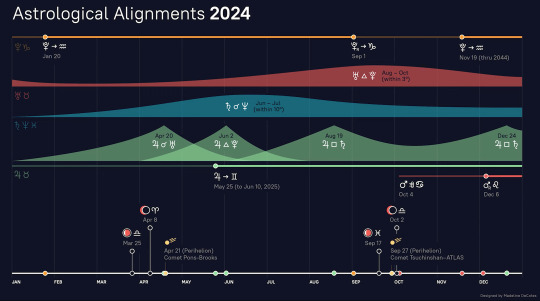
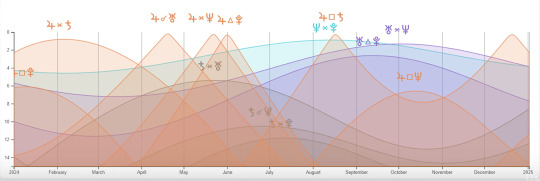
Overview
This year would be dramatic on its own, but with bigger shifts ahead in this decade, serves as a preview for even more dramatic changes in 2025 and 2026.
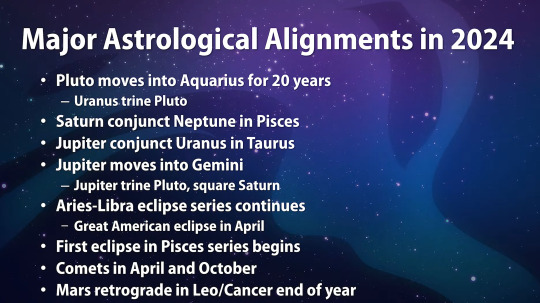
Pluto in Aquarius
We only got about 6 weeks of Pluto in Aquarius in 2023, but this is will it where be for most of 2024 and the next 20 years. We're also getting the last of Uranus in Taurus (7-year transit) and Neptune in Pisces (14-year stay). These outer planets are wrapping up while Pluto starts something new.
Austin predicts Pluto in Aquarius will be a relief to those of us who've been suffering from Pluto in Capricorn. Historically, Chris traces the development of gunpowder, its refinement and transmission from China to Europe with Pluto in Aquarius. Warfare changed with these developments, particularly the strategies of siege. We should expect to see new technologies & applications in warfare now, particularly anti-drone weapons and uses of AI. Near-future science fiction stories from 20 years ago will look incredibly familiar, especially the "cyberpunk dystopia" and man-machine interfaces changing significantly. The first paper shop was set up in Baghdad in 793 under Pluto in Aquarius, and this technology spread around the world under different Pluto in Aquarius periods, with wide-ranging effects on mass communication. Technological espionage is also a theme of this placement--think AI uses, and the US trying to compete with Chinese microchips. This will also form an opposition to natal Pluto for baby boomers (1940s-60s), a transit that rarely occurs within a human lifetime. We'll see the culmination of this generation's power in the world, where figures like Biden or Trump or their contemporaries may have one last bid for power before they have to hand it to someone younger.
Chris actually used AI to help summarize his notes on this transit. With Pluto representing transformation and control, and Aquarius indicating the innovator and the rebel, some general themes are:
Major shifts in how technology shapes society, both empowering people and destructively.
Information warfare and control, especially among governments. Monopolies and censorship attempts will increase.*
Technological leaps. Breakthroughs from both internal research and external sources like cultural exchange or encounters with "that which is foreign/alien."
Science vs ethics: moral dilemmas, tension between curiosity & caution
Globalization on edge: the interconnected world may face challenges, but the exchange of information is crucial to progress. World trade and supply chains spanning the globe will change as countries shift certain sectors to more local production.
*history note: Pluto was in Aquarius during the Renaissance & Scientific Revolution, and the Church tried to censor this new information because it posed a threat to Papal power. Monarchs took state power from the church under Pluto in Aquarius, and the French Revolution under this placement showed the bourgeoisie really challenging the nobility under this placement. Most of the US constitution was written under Pluto in Aquarius--in fact the last Pluto in Aquarius period was during the late 18th century, so prepare for those paradigm shifts & revolutions to shift and revolt once again. New developments in physics and cosmology around dark matter and string theory, increased uses of AI, and new space probes may all prove to shake our ideas of where we stand with the rest of the universe.
Saturn conjunct Neptune
Saturn prefers structure & the real world, while Neptune is a realm of imagination and illusions. In 2016 these planets squared each other and the political sound byte "fake news" was important. We no longer trust sound and video in addition to images, especially with advances in AI. Previous Saturn-Neptune contacts include the dissolution of the Soviet Union and the HUAC/McCarthy era in the USA. We'll be asking ourselves, "is this real?" We'll need to balance skepticism with imagination.
Another Saturn-Neptune in Pisces theme is pervasive feelings of despair and collective sorrow over water-related disasters, such as tsunamis or the devastation of Hurricane Katrina. The first Saturn-Neptune conjunction of the 20th century was 1916-1919: disillusionment, skepticism, muddy trench warfare and chemical weapons. More positively, empathy, compassion, and service can come from those who fight for a better world despite hardships. However, Neptune will conjoin Saturn in Aries as well, which will have a much less compassionate flavor. This upcoming Pisces conjunction occurs right as Neptune is leaving the sign--which Piscean developments will get the Saturn stamp of approval and last beyond this decade? Neptune in Pisces has brought us an increased interest in the occult matters and psychedelics, ranging from tarot and astrology to modern cults to therapeutic uses of hallucinogens. Some of the skepticism we see will be the result of having been burned by Pisces Neptune events. Another related topic is augmented reality displays--Austin predicts that since it's been around for so long, if it doesn't take during Neptune & Saturn in Pisces, it probably won't take at all.
Jupiter conjunct Uranus in Taurus
This conjunction goes exact in April. In the material sign of Taurus, what sudden developments (Uranus) is Jupiter enabling? In one such application, AI technologies can help advance the field of materials science by designing new compounds & predicting their uses. There are a lot of technological developments bottlenecked by a single limitation, such as limited battery capacity, which if resolved would prompt an explosion of impressive new technologies. Quantum developments, Heisenberg's additions, different political revolutions, the sexual revolution & the Moon landing were under Jupiter-Uranus alignments, as were some of the earliest biology works in the Renaissance era. April will breakthroughs getting supported and confirmed. These come about every 13 years: in 2010 in Aries, 1990s in Aquarius. In 1941 we saw scientific breakthroughs as well, though Saturn's presence fittingly brought a much darker tone. Which house is Taurus in your chart? This transit can bring sudden insight & broaden your horizons in this area (A/N: timing techniques like progressions, Hellenistic profections, and zodiacal release can help you determine if Taurus will be especially "activated" for you around this time).
On the flipside, take care not to indulge in excessive naivete, uncritical embrace of rule-breaking in the name of progress, or getting caught up in fleeting euphoria. Once Uranus leaves, what will stay? What gets truly confirmed by Jupiter? Austin predicts major developments in cryptocurrency, which was not invented under Uranus in Taurus but did rise to prominence under this transit. Taurus also tells us to appreciate the material comforts, and this conjunction may show us a new approach to appreciating these things (like an AI snuggy that helps you sleep!). The potato chip and chocolate-chip cookie were also invented during Uranus in Taurus. More niche items have become more widely available (lab-grown meat, perhaps?), though food and energies has also become disproportionately more expensive/volatile during this transit. Taurus also signifies nature, botany, and ecology--we may see major developments in response to climate change. This is the last year of Uranus in Taurus--perhaps the cottagecore trend will have its last blows. Uranus in Gemini (A/N: 2025) will have us going back into the mainframe...(organic computers?)
Jupiter in Gemini
This transit will be about a year long. Immediately upon entry to this sign Jupiter will trine Pluto, and later in the year he'll square Saturn. This will be a big shift, not just by sign, but because Jupiter goes from cooperating with Saturn to fighting him. Light-footed, fast, clever Gemini Jupiter clashes with deep, slow, heavy Pisces Saturn. Their sextile in January/February indicates the economy will likely seem to move in a good direction as the year begins, but the leviathan in the deep will stop us short.
Notable figures born under Jupiter in Gemini & Saturn in Pisces include Alexander Graham Bell and Thomas Edison, bringing us new communications systems. Bell developed the telephone partially as part of efforts to help his mother and other deaf people, while Edison himself had major hearing issues and focused on visual phenomena. However, we have ethics questions too: Bell had issues patenting the telephone as the same day as another inventor--who got there first? (A/N: many of Edison's patents were invented by others with property rights surrendered to him.) Trent Reznor of Nine Inch Nails also has these placements, and he's gone from applying electronic music in rock to films in recent decades. Also born under Pisces Saturn & Gemini Jupiter: Moby, Björk, Alfred Pulitzer (known for pioneering both human interest stories and sensationalism).
Other Jupiter in Gemini keywords: speaking many languages, verbosity, versatility & adptability, self-education, many short experiments, and having a knack for or good luck in new machines. However, Jupiter is considered in exile/detriment in Gemini: this light sign may interfere with Jupiter's desire for deeper understanding. The first decan of Gemini is ruled by Jupiter, and the bound of Jupiter is early in the sign as well, (and Jupiter is a triplicity ruler for Gemini!) so we can actually have quite a strong Jupiter in the beginning of this transit. Pluto in Aquarius trines Jupiter at the start of this transit, and Jupiter will gladly go to work for Pluto's agenda. Expect major technology & information related developments in April-May. This also foreshadows Uranus's entry into Gemini, where he'll trine Pluto thrice.
During this time, all the planets in Gemini are also combust (so close to the Sun we can't see them, figuratively getting burned), so beware of burnout. Another Jupiter in Gemini native is Lana Wachowski (one of the creators of The Matrix). Her coming out story also inspired many, and Jupiter in Gemini is a good place for variety in gender expression. Unfortunately, concepts from her movie were also coopted by right-wingers ("redpilled"). Also under this placement is JK Rowling, initially known for writing increasingly verbose fantasy books, though in recent years has focused her resources on stopping the advancement of trans rights. Jupiter in Gemini is fast, but not always ethical.
Eclipses
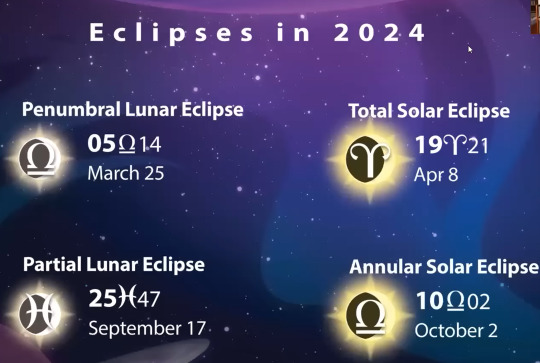
In April we'll have an eclipse that's visible over much of the United States from Texas to Maine, occurring on an election year. In the Indian dasha system, the US entered a Rahu (North Node)-ruled time period 8 years ago, making it especially sensitive to eclipses. There won't be another total eclipse visible in the US until 2045, marking momentous changes. This is also a continuation of the Libra/Aries eclipse story, most recently from the Libra eclipse in October. In both our personal lives and world events we'll see a turning point in the spring. The eclipses this year are in March-April, and September-October (remember, eclipses always come in twos--one lunar, one solar!). The March/April eclipses will be especially chaotic with Mars-Saturn and Jupiter-Uranus conjunctions affecting the equinox. The fall eclipses will begin shifting towards the Pisces/Virgo axis, and the major renewals will shift focus from one area of our lives to another (check which house(s) contain these signs for you).
Comets
2024 will have two comets that may be visible to the naked eye--both during eclipses! The Pons-Brooks comet will be visible in April around the time of the Aries eclipse (and Jupiter-Uranus & Mars-Saturn conjunctions). This indicates a very important time in world history. The comet, which may become visible as the sky darkens, will pass right by the Jupiter-Uranus conjunction. Chris's ancient sources say whether a comet is a good or bad omen depends on its color, brightness, and visibility once it gets here, but he's hopeful its contact with Jupiter-Uranus will be helpful to us. Austin points out it'll be difficult to distinguish the comet's specific effects from everything else going on at that time. The second comet visits us in October, right before eclipses and the US presidential election. "Hopefully we won't get the Game of Thrones Season 2/War of Five Kings comet," says Austin. Chris is going to publish an episode soon analyzing both ancient sources & doing his own historical research on comets, which have connections to wars, regime changes, and religious or political leaders being born.
Mars
Austin points out that there will be consistent stelliums in the first half of the year (visible around the eclipses) before returning to more regular dispersal. Mars is also going to make volatile contacts to outer planets as well, really bringing military connotations, mostly earlier in the year and then picking up again at the end of the year with an opposition to Pluto & a retrograde. In fact, Mars enters Leo, the sign of his upcoming retrograde, 2 days before the US presidential election.
US history & election: Mars goes retrograde in the same sign every 79 years, shifting by about 4 degrees every time. Mars did this same retrograde back in the late 1700s when US states were ratifying the Constitution (Pluto was in Aquarius then like it will be in '24, and some other transits are the same as well). The next recurrence was during the passing of the 14th amendment after the Civil War, an amendment forbidding anyone who led an insurrection from entering office. Most recently Mars retrograded in this cycle in 1945-6, during the end of WW2 and stationing just before the birth of a certain controversial recent president. This upcoming Mars retrograde will occur in the same part of the zodiac as these other events.
Chris usually shies away from predicting election results outright because he considers himself too invested to be objective, but he gives us a rundown. Like 2016 this election occurs under a Saturn-Neptune conjunction, foreshadowing the us of AI in political propaganda. If it does end up being Biden vs Trump, Chris says as of now there are indicators for either side winning. For the past 30 years, every presidential election winner has had an eclipse in one of his angular houses (1/4/7/10) shortly before winning. The Aries/Libra eclipses don't fall in angular houses for either, but the Pisces eclipse in September occurs in Biden's 4th house, and the 10th of his running mate Kamala. In Trump's favor is zodiacal releasing: he's starting a 19-year peak period releasing from spirit (career/aspirations) in 2025 just after the election. (This is one of the things that threw Chris off in the 2016 election, since a president elected for 2 consecutive terms then wouldn't be in office anymore in 2025.) This peak period activates the sign of Leo for him, the first house, and contains his natal Mars, bringing fighting and difficulty to the foreground. (A/N: Mars is also entering Leo around the time of the election, so whether he wins or not, we'll be seeing a lot of him.) That's a basic overview, and Chris will discuss other factors as the year progresses. Austin points out we have a perfect Mars-Pluto opposition the day before the election, and Mars stations in Leo right as the electors meet to officially vote. This election is heavily tied to the Mars retrograde, which continues until a few months into 2025. Pluto will take Mars's significations to bigger extremes as well as hidden power plays. Taking place January 20th at noon, Inauguration Day always takes place at the beginning of Aquarius season with the Sun in the 10th house, but Pluto's going to conjoin the Sun as well this year, which Chris predicts will start a new era of American history. Two of the debates fall on eclipse days, and Chris predicts these will have a dramatic effect on the election. Regardless of specific candidates, we know the US is entering a crucial phase of its history with Uranus entering Gemini (same placement as the Revolutionary War, the Civil War, and entering WW2). Austin wonders if the Saturn-Neptune conjunction will delay the rise of historic leadership, as his research so far proved inconclusive.
Month-by-month
January

Mercury stations direct immediately, helping us start things off definitively. Mars in Capricorn colors most of the month. He's very strong & effective in this sign, further supported by a trine from Jupiter in Taurus. With Venus and Mercury copresent Mars in Capricorn, we have an opportunity to practice living how we'd like to before things get crazy. The clichés of "starting your the year off right" are worth following this time around. A Jupiter-Saturn sextile in the first six weeks of the year further supports our efforts to get organized. Take advantage of Jupiter in Taurus to make the growth and expansion you seek permanent. We'll need a set pattern to weather the upcoming storms.
Chris and Leisa's auspicious election for the month is on January 12th, 2023 at 8AM local time with Aquarius rising. This means the Ascendant ruler Saturn receives a helpful sextile from Jupiter (orb of 5 degrees).
After a conjunction with the Sun and the light's ingress into Aquarius, Pluto re-enters that same sign on the 20th, anchoring what's most interesting about February. Chris points out it's exactly one year from the US presidential inauguration and will be an interesting omen.
February

February has a pileup of planets in Aquarius. From the 5th to the 16th, Mercury, Mars, and Venus all conjoin Pluto. This rapid succession of initial conjunctions will start to show us what this new Pluto era will look like for each of the faster planets. We go from having 4-5 planets in Capricorn to having 4-5 in Aquarius through this first half of the year. What does overwhelming weight in these signs look like for you? The Mars-Pluto conjunction on the 14th will be pretty dramatic. This connotes the use of excessive force, and generally will likely show us what kinds of dangers to expect from Pluto in Aquarius. The Venus-Mars conjunction at nearby degrees will connote future relationship patterns.
March
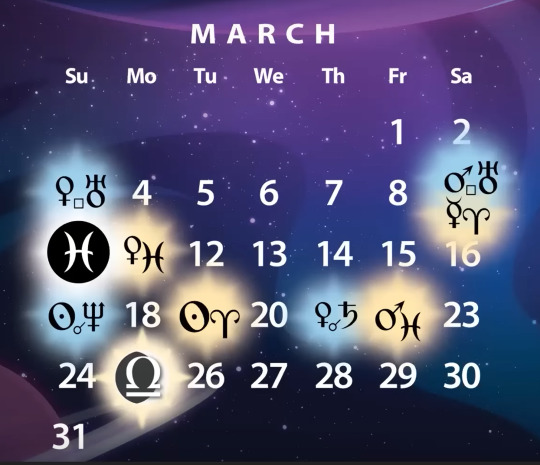
This month marks the beginning of eclipse season as well as a pileup of planets in Pisces. After the equinox, we have an eclipse, making the spring very dramatic. Mars sneaks up to a conjunction with Saturn, who rules the April Libra eclipse, and all the while Mercury is retrograde. We have multiple indicators of major world events here, which Chris compares to early 2020. And if that wasn't enough, we've got a comet! The lunar eclipse in Libra heralds back to its sister eclipse in early October.
April

The Mars-Saturn conjunction will punctuate difficulties of Saturn's transit--the last Mars-Saturn conjunction in Aquarius aligned with the intensifying lockdowns in March-April of 2020. This time the conjunction is in a water sign, so think naval warfare or threats from aquatic creatures. January was a good time to plan; this is not. We'll be adapting to rapid changes and doing what needs to be done. The Aries eclipse will be visible over much of the US, bringing major developments to the nation. Once we get out of eclipse season, we'll have to deal with the Jupiter-Uranus conjunction going exact on the 19th. Chris hopes that this will divide the month in half, from chaotic early on to more hopeful in the second half, especially as Mercury stations direct. Austin is less optimistic, as we'll have Jupiter, Uranus, and Venus all in Taurus. At the end of the month, Mars enters Aries and joins Rahu there, igniting the very point that was just activated by a total eclipse. Regardless, the pace of technology and communications will explode during this month and May.
May
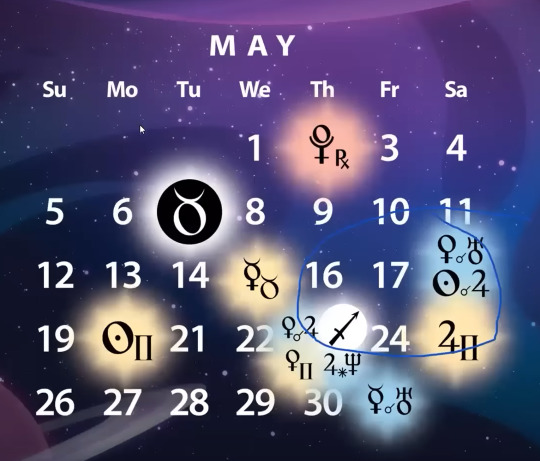
Once Jupiter enters Gemini, lots of other planets follow him to that sign. This has strong implications for the advancements for communications. Austin says the Taurus developments in the early month indicate financial developments before the technological ones. All the planets in Taurus are looking to its ruler Venus for support, but she's combust (close to the Sun & invisible), so we'll feel something missing from our material comforts.
June

The Jupiter-Pluto trine is twofold: Jupiter expands Pluto's Aquarian pursuits, while Pluto exponentially magnifies Jupiter's expansion of communications in Gemini. We get a Sun-Venus cazimi in Gemini, resetting her cycle, with Mercury a few weeks after. Some of the Jupiter-Uranus discoveries and inventions may not be visible until later, as the Gemini planets themselves are invisible & passing through the Sun during these few months. There's a spaceship with recreational implications set to be launched next spring, fitting with the expansion of leisure that Jupiter in Taurus connotes. Mars entering Taurus on the 9th will mellow out for awhile after such intense movements. Saturn's retrograde station in Pisces brings him as close to Neptune as he's gonna get this year.
July

Saturn & Neptune stationing in Pisces blur the lines between what's real and what's not, what's true and what's false... An exlposive, unexpected Mars-Uranus conjunction occurs on the 15th. Furthermore, it's on top of the star Algol, a very ugly configuration that has historically coincided with devastating warfare and weapons. This isn't the tone for all of Mars in Taurus, but it's something to try and steer around if possible. Mars in Gemini brings us to August.
August
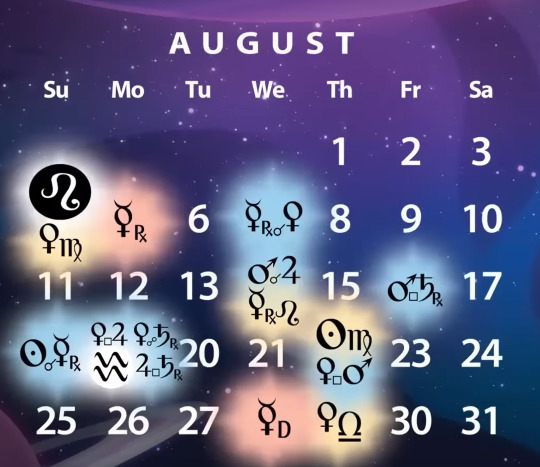
Mercury stations retrograde on the 5th, backtracking through both Virgo and Leo. This year Mercury retrogrades occur mainly in fire signs:

Mars in Gemini puts him in contact with Jupiter right as the benefic is squaring Saturn in Pisces; the smaller planet will likely exacerbate these issues. Excessive heat and speed clash against excessive cold and slowness. This is a real slowdown for Jupiter's fun and social trip through Gemini. Mercury stations direct by the end of the month, taking us into September.
September

By this point the planets have stopped moving in a giant pack, spacing out the energies a little. Pluto retrogrades back into Capricorn for the very last time this month; when he enters Aquarius at the end of this year he'll stay there for the next 20 years. Uranus gets as late into Taurus as he's gonna get this year before stationing retrograde as well, trining Pluto within 2 degrees of exactness. Chris charts these planetary contacts over the past few decades:
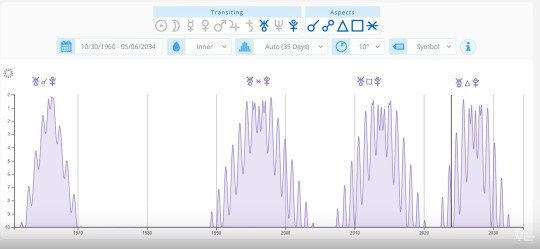
Uranus conjunct Pluto in the late 1960s saw major social changes as well as the first computer mouse. A sextile in the mid-1990s heralded the emergence of the Internet as we know it. In the early 2010s, smartphones became more and more ubiquitous, and now we're entering the next phase of new widely used technologies. The 2010s also saw revolutionary movements like the Arab Spring, and similar political developments will be foreshadowed around this time.
Mars enters Cancer, the sign where he'll retrograde. It's not very comfortable, but we'll have to get used to it all the same. Notable degrees are the retrograde beginning at 6Leo10 and ending at 17Cancer01:
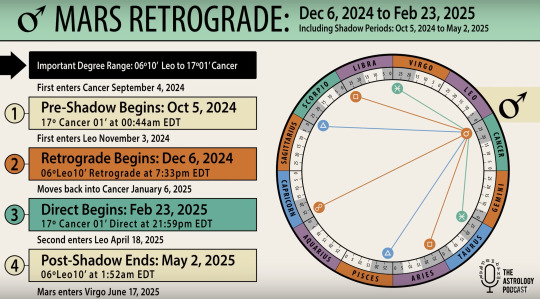
We also get the first hit of the Pisces eclipse series this month. Though its companion eclipse is back in Libra, the September eclipse is foreshadowing for 2025-6.
October

The height of election season in the US coincides with the height of eclipse season celestially. We'll likely see prominent figures suddenly sink to the bottom or rise to the top around this time--jumping way ahead or falling way behind. Mars enters the shadow of his upcoming retrograde days after the eclipse. It's already hard to see clearly, and the eclipse supercharges all this. The Libra eclipse on the 2nd is the final of its series, wrapping up whatever was initiated in October 2023 (i.e. a new chapter in certain Middle Eastern conflicts). The first lunation free of an eclipse provides no relief, with the Full Moon tightly squaring Mars (♋) and Pluto (♑). This forms a difficult cardinal grand cross with the Sun, Moon, Mars and Pluto. Power plays, manipulation and intrigue abound.
November
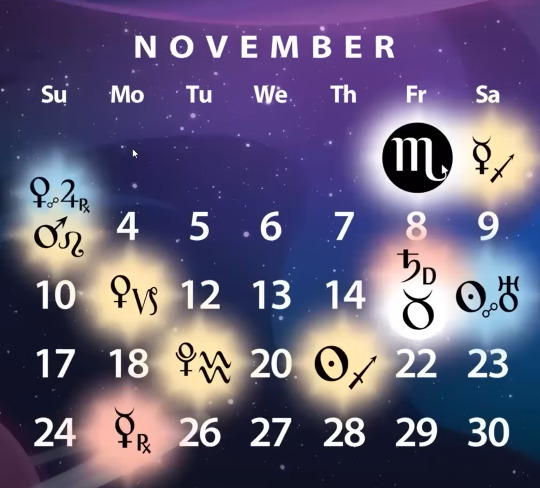
Mars enters Leo, the sign of its retrograde, on the 3rd. Although he's in his pre-retrograde shadow period earlier, this ingress will bring it dramatically forward. He opposes Pluto, who's been stationing since mid-October, bringing paranoia, power struggles/plays, obsession & confrontation, and hidden motives or manipulation from behind the scenes. In opposite signs we'll see tension in opposite approaches to things, such as direct power versus hidden agendas, excessive force and even extermination. Mars only needs to win the battle, but Pluto blows things out of proportion. His station on December 6th is notable. The last Mars retrograde in Cancer was in 2007-2008, so look to this time in your life for an idea of what will happen. We can also look to the Mars retrograde in Leo 15 years ago (12/20/2009-3/10/2010). (This retrograde is mostly in Cancer, but stations in Leo). 2 days after Mars enters Leo is election day in the US (Nov. 5th), shining a light on all the controversies.
Venus is way ahead of everyone in Capricorn, while Pluto reenters Aquarius for good (the next 20 years). Mercury also stations retrograde at the end of the month, bringing us to December.
December

Mars stations retrograde right after Mercury's own halfway point through the retrograde, bringing miscommunications into Martial clashes, conflicts, and severing/separation. It's during the height of his retrograde that Mars is at his closest to Earth and is at his brightest for the longest (basically all night every night).
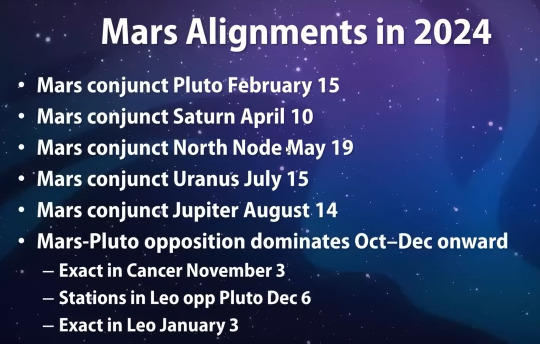
Mars retrograde shows us that no battle plan survives first contact. Excessive heat or conflict will linger for much longer than you expect. Mercury stations direct under a Full Moon on the 15th, and Jupiter squares Saturn exactly on the 24th. Our questions about growth versus boundaries will come back into focus. Meanwhile the rest of Mars retrograde awaits us in 2025, continuing a smoldering conflict into the next year.
#astrology#transits#2024#forecast#the astrology podcast#pluto in aquarius#saturn conjunct neptune#aries eclipse#libra eclipse#pisces eclipse#mars in leo#mars retrograde#mercury retrograde#mundane astrology
41 notes
·
View notes
Text
Breakdowns of How I Characterize the Koopalings
Ludwig:
“Classy”, grandiose and insufferably smug. Unlike Larry, you cannot convince Ludwig he isn’t hot shit, no matter what you do. After Iggy, Ludwig is the best at plotting and since Iggy keeps his schemes to himself more often than not, Ludwig usually plays the mastermind in the Koopalings plans. (Ironically, Iggy is the one whose plots are generally built on self-interest. Ludwig is more likely to scheme for the goals of the Koopalings and Koopa Kingdom as a whole— just as long as everyone is clear it was HIS brilliant idea.)
Ludwig loves the classical arts, the sciences and anything else that will reinforce his belief of being smarter and more cultured than the other Koopalings. He sees himself as their leader and essentially he is— not because they respect him more, but because he is the one most interested in actual conquest and warfare, so when Bowser gives them an assignment Ludwig is usually the one who takes the initiative to make a plan and assign all the others different tasks. Ludwig can often be found sequestered away somewhere playing music, painting, tending to his Piranha Plant garden or otherwise looking pretentious and unbothered.
Lemmy:
Silly and fun-loving, not particularly evil. Pretty content to go along with whatever the objective of his family is. Of the Koopalings, he’s the most likely to be friendly with the Mario Brothers/not DIRECTLY injure them/defect from Bowser. However, this isn’t necessarily because he believes in the cause of GOOD, but just because he’s more concerned with his own entertainment than any particular ideology or group (not in like a “mwahaha you are all my toys” way, but in a way where he kinda treats everything like a fun little game and just doesn’t seem super concerned with the consequences of anything). Lemmy surrounds himself with games, toys and amusements. He’s something of a G-rated hedonist.
Roy:
Stereotypical bully. Gets a kick from violence, thinks he’s really cool, always seems to be in that bully mood where they’re wearing a mean smile because they’re at the top of the food chain but they also seem really angry.
Though he has the capacity to be high energy and DOES like beating people up, Roy’s also kinda lazy, preferring to intimidate others into doing the hard work for him while he kicks his feet up (unless his pride is on the line). He will not charge into battle like Morton or desperately try to prove himself like Larry. Forcibly enrolled in night school by Kamek to try and whip him into shape (but he’ll act like it was his own idea when it makes him look good).
Iggy:
Manic, sadistic, always giggling with the kind of laugh that makes it seem like he knows (or thinks he knows) something you don’t. Like something bad is going to happen, and you could avoid it if you knew about it, but Iggy is deliberately keeping it to himself. Very cunning, probably plotting at any given moment, but no one ever knows for sure (Lemmy is the only one who generally is party to Iggy’s plans, but he doesn’t tell anyone because it’s fun to watch the fallout after).
He and Ludwig both have a passion for mechanical engineering. Iggy is actually a BETTER, more innovative inventor than Ludwig, but (being generally more secretive and enigmatic) he’s not as much of a show-off about it, so Ludwig usually ends up presenting himself with a more blatant “technology” motif (although it’s mostly stuff he didn’t actually make, like Bob-ombs, Mechakoopas and airships). Iggy’s stuff often has more of a “scavenged” or “cobbled-together” look than Ludwig’s, but where Ludwig gets by on only innate affinity, Iggy has actual honed skill and study, meaning the machinery he creates is usually more diverse and technically impressive. He just tends to keep it to himself. (Iggy’s equivalent to Ludwig’s natural-but-unhoned talent for technology is his skill in taming animals— particularly Chain Chomps).
Iggy’s also just kinda weird. He wanted a “cheese hotel”.
Wendy:
Greedy. Also a bit vain, which partly contributes to the greed— she wants baubles and pretty, shiny things. Wendy has a taste for glitz, glamour, and secret hordes of gold and jewels. Her aesthetic ostentatiousness is similar to Ludwig’s, but Wendy usually goes for a more flashy, white-marble-sculptures, “art deco” or “fancy hotel/casino” vibe, while Ludwig leans towards “sprawling Gothic manor/castle”.
Wendy’s also somewhat short-tempered. “Angry” is not her default, but she does appear to get mad more easily than most of her brothers (save Morton). Seems constantly annoyed (at best) or infuriated (at worst) with the “fools” around her, thinks she knows better. Bit of a mean girl.
Morton:
Like Roy, Morton is kind of a brute. The difference is that Morton is more brash and temperamental/doesn’t “play it cool” as much as Roy. Roy always seems angry, but there’s also a hint of smugness. Like he’s not TOO concerned, because he already knows he’s better than you. Morton definitely comes off as a lot more invested in his battles/genuinely fully INFURIATED by his foes— Roy is violent because it’s fun, Morton is violent because he’s easily angered to the point of violence. He’s also more likely to charge into battle without thinking (it’s not exactly that Roy is more tactical, just more lazy). Not a big smiler or joker.
Although he is deeply devoted to his family (and NO ONE else), Morton is not SPINELESS. Matter of fact, he is incredibly stubborn and no stranger to arguments with his siblings (mostly Roy). Morton never backs down from anything— he may move slowly, but once he starts, he can’t be stopped. Not really STUPID… but not really smart, either. (Morton is a bit insecure about seeming dim-witted, and sometimes sits in on Roy’s night classes. He’s still only really of average intelligence and lets his temper lead him into situations without giving them as much thought as he perhaps ought to, but he CAN recite long passages of the textbooks and lectures from memory at breakneck speed. Roy uses it to cheat on tests and essays.)
Larry:
Like a snarky, annoying 90s protagonist who thinks he’s hot shit (very easily angered by the implication that he is not hot shit— he’s got something to prove). Into sports. Larry is deeply envious of anyone in the Koopa Troop who gets more respect or recognition than him, intensely desires Bowser’s approval and tries to scheme against his siblings to get it about as often as he schemes against the Mario Brothers. His siblings tolerate it because his machinations are always excruciatingly obvious and unsuccessful. Despite his rank-climbing ambitions, though, Larry is not a suck-up. He has JUST enough dignity to avoid that. Claims he is the leader of the Koopalings. All the rest either say Ludwig is or that they don’t have one. (Wendy says she SHOULD be the leader, but not that she IS.)
#roll the bones#super mario#super mario bros#koopalings#larry koopa#morton koopa jr#wendy o koopa#iggy koopa#roy koopa#lemmy koopa#ludwig von koopa#none of them are really supposed to be particularly likable#morton has his moments and lemmy is supposed to be unlikable in a way that’s not really his fault#he really does just act like he’s playing#but he acts like that when lives and other serious things are on the line and that’s what makes him disturbing/villainous#but in general they just love being mean
18 notes
·
View notes
Photo






DOUBLE-0 | A NETFLIX SERIES
Synopsis: When a former MI6 Quartermaster and gifted innovator creates AI technology that will change the world of espionage and military warfare forever, an arms race ensues to acquire such a invention. But in order to stop such equipment from falling into enemy hands, Bond must confront a familiar friend and past flame. Can he put his feelings aside for the sake of the mission? Or will love blind him again?
Thanks to @bitchronan for the Netflix template!
Read the fic here
#was just about to write this fic when I thought why don't I just make a moodboard#well here you go#the love triangle you didn't know you needed ;)#if you'd like this to be turned into a fic please let me know!#james bond#casino royale#le chiffre#daniel craig#jodie turner smith#mads mikkelsen#black!oc#ai technology#spy au#netflix au#james bond au#jamesbondedit#netflixedit#au#quartermaster#james bond x oc#le chiffre x oc#james bond fanfiction#james bond fic#james bond imagine#le chiffre imagine#le chiffre fic#le chiffre fanfiction#litedit#bondedit#00
112 notes
·
View notes
Text
Israel has long branded itself as a purveyor of the latest and greatest in homeland security. Military spokespeople have held up the blockaded Gaza Strip as proof that innovations in surveilling, shooting, and killing from a distance can make warfare more precise. However, just as the billions of dollars sunk into cutting-edge security solutions did not prevent the ruthless massacre of Israeli civilians, these technologies are not preventing but inflicting wholesale destruction across Gaza. The brute bloodshed has exploded one of militarism’s popular mythologies: technological innovation will deliver more humane warfare.
47 notes
·
View notes